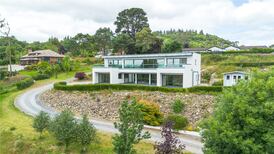The sale of a major Irish stud farm in Co Kildare – whose neighbours include the Aga Khan and a Saudi prince – is likely to attract worldwide interest, writes MICHAEL PARSONS
DURING her official trip to Ireland in May, Queen Elizabeth took a well-deserved break and paid a private visit to the Aga Khan’s Gilltown Stud near Kilcullen. It’s not known if the neighbouring stud farmer – Prince Khalid Abdullah of Saudi Arabia – joined them for lunch. Her Majesty might have been bemused to discover that this corner of our Republic is teeming with toffs. The country lanes around north Kildare shield some of Ireland’s wealthiest and most discreet households.
Other property owners include Sheikh Mohammed bin Rashid Al Maktoum – the supreme ruler of Dubai and vice president of the United Arab Emirates – and the home-grown gentry, Sir Anthony and Lady O’Reilly.
Fancy getting a foot on this thoroughbred property ladder? Well a very grand estate, at the epicentre of what is the world’s greatest bloodstock belt, has just come to market. It is likely to attract whinnies of interest among magnates and potentates from Coolmore to Qatar, Dubai to Windsor.
Newberry House and Stud is located just outside the town of Kilcullen on 170 acres adjoining the River Liffey. The executor’s sale, by private treaty, is being handled by Coonan REA of Maynooth and the guide price is “between €4 million and €5 million”. The property is just 26 miles (the horsey set doesn’t do metric) from Dublin while The Curragh, Punchestown and Naas racecourses and Goffs – are just a canter away.
Newberry was originally built in the 19th century by the Anglo-Irish Tickell family – and was originally known as Carnalway House. Most recently, Newberry was home to Lady Margaret Clague, a prominent racehorse owner and breeder who died, aged 89, in February.
Originally from the Isle of Man, she moved to Kildare when her husband Sir Douglas Clague acquired the estate in the early 1970s. He was a Rhodesia-born, British second World War hero whose exploits battling the Japanese earned him a knighthood.
He settled in Hong Kong after the war, helped to run the colonial government and later established a vast business empire – with interests in banking, trading and publishing – which made him one of Asia’s richest men.
He was chairman of the powerful Royal Hong Kong Jockey Club and responsible for the building of the famous Sha Tin racecourse. His global bloodstock interests eventually drew him to Ireland. He died in 1981, aged 64.
The estate is being sold by Lady Clague’s heirs. It is still being maintained by resident manager, the affable and knowledgeable Pat Murtagh, after four decades of service. He’s one of those unsung champions who keep the Irish countryside shipshape.
A smart entrance, via electric gates, and the obligatory winding avenue leads to a courtyard-fronted house at the centre of the property, sheltered by mature trees and offering complete privacy – always an important consideration for the very rich. The two-storey, eight-bedroom, house of some 743sq m (8,000sq ft) appears in very good nick with the usual period fixtures – shutters, wood panelling and fancy fireplaces – but is hardly likely to be the only home of the family who may end up owning it.
A grand entrance hall leads into a dual-aspect, light-filled house with a series of elegant reception rooms and spacious country house kitchen and utility rooms.
There’s a children’s wing – a splendid concept championed by the Victorians to ensure that the little blighters are tucked away with nanny before adults come down to dinner. A large billiard room is equipped with a full-size mahogany table while the diningroom is still furnished with a table that could comfortably seat the entire Irish peerage.
Upstairs, the bedrooms are accessed from a long enfilade-style window-lit corridor. The vast bay-windowed main bedroom suite has separate “his” and “her” bathrooms and a secret door leading to the west wing which houses an indoor heated swimming pool – bigger than is often found in five-star hotels – with a changing room, extensive seating area, snack-kitchen and dining area.
Outside, extensive yards and outbuildings offer almost equally opulent accommodation for the horses – with extensive stabling, haybarns, farm offices and a seating area beneath a pagoda from where to watch the fillies parade.
If you tire of the equine world, the house is surrounded by cleverly-designed gardens. A Japanese section (the National Stud isn’t the only possessor of oriental pleasure grounds in Co Kildare) features an ornamental water garden and footbridge and a traditional tea-house Chashitsu – built of teak – that was airlifted into place. A traditional stone foot-well has been installed so that Kimono-clad guests are “cleansed” before stepping into the the Tatami-floored interior.
A little wood, cultivated to appear wild is dotted with pieces of imported Japanese granite sculpture and leads, unexpectedly, to a separate Spanish garden evoking the Alhambra. Extensive lawns, south of house, undulate gently down to a mile-long stretch of private frontage on to the River Liffey with a series of dappled trout pools.
Needless to say, this is a lifestyle that requires a considerable supporting cast of staff and they can be accommodated in a manager’s bungalow, a gate lodge and a three-bedroom apartment described as “suitable for senior household staff”. No money in the country? Well, there is in Kildare. Where there’s mucking out there’s brass.








